Winter 2023
Create successful ePaper yourself
Turn your PDF publications into a flip-book with our unique Google optimized e-Paper software.
ACADEMIC CORNER<br />
INSECTS: MAKING A BUZZ<br />
ABOUT GREEN ROOFS<br />
In his latest Academic Corner column, Dr Tom Young of TEP<br />
focuses on entomology and the impact of green roofs on insect<br />
habitats. To help find out more about the role of entomologists<br />
and what can be done to improve green roofs as habitats for<br />
insects, he taps into the knowledge of expert Dr Konstantinos<br />
Tsiolis of Pollinating London Together…<br />
Above: Dr Tom Young, article author.<br />
Green roofs can provide fantastic habitat for insects<br />
in urban areas. With this in mind, GRO has recently<br />
helped to publish a children’s book on this topic in<br />
collaboration with Tales from Mother Earth, which is available<br />
to buy at https://talesfrommotherearth.co.uk/product/<br />
journey-to-the-green-roof/. However, this is an area I know<br />
very little about, and so to explore this topic further I thought<br />
I would enlist the help of Dr Konstantinos Tsiolis, who is a very<br />
knowledgeable pollinator ecologist and entomologist, who works<br />
for Pollinating London Together.<br />
The academic literature on the topic of insects and green roofs<br />
is still relatively sparse, but has improved in recent years as the<br />
role of green infrastructure in urban ecology becomes better<br />
known.<br />
In general, the consensus is that green roofs, compared to<br />
normal roofs, attract significantly more biodiversity to cities,<br />
which includes birds, insects and other invertebrates (Wooster et<br />
al. 2022). This can have knock-on effects across the food chain.<br />
For example, a study on a large green roof in New York found<br />
that bat feeding activity on the roof was strongly correlated with<br />
the presence of a certain type of moth. This moth was attracted<br />
to the green roof due to the vegetation and habitat provided,<br />
which in turn attracted the bats, providing them with a valuable<br />
food source (Partridge et al. 2020).<br />
However, all green roofs are not the same, and changes in<br />
vegetation type, vegetation coverage, substrate type and<br />
additional microhabitat features all combine to determine how<br />
effective green roofs can be for insects (MacIvor & Ksiazek<br />
2015). In addition, the size of the green roof and type / quality<br />
of surrounding habitats all play a part (Ksiazek-Mikenas et al.<br />
2018), and native plants have been shown to increase insect<br />
abundance on green roofs (Fenoglio et al. <strong>2023</strong>).<br />
To better understand how people become entomologists and<br />
what can be done to improve green roofs as insect habitats, I<br />
asked Dr Konstantinos Tsiolis a few questions about his career<br />
and work with Pollinating London Together (PLT).<br />
Tom Young (TY): What is your<br />
background?<br />
Konstantinos Tsiolis (KT): I come<br />
from a small rural community in Cyprus<br />
where the region’s primary income<br />
was traditionally from crops such as<br />
hazelnuts, almonds, vines, cherries and<br />
apples. I have grown up working on our<br />
family farm, helping cultivate crops and<br />
selling our produce at various markets.<br />
The quality of our family life was always<br />
dependent on the yield of our farm,<br />
and I have experienced first-hand<br />
the frustration and negative financial<br />
impacts of low yields at times. My<br />
parents have only completed primary<br />
education but are rich in valuable<br />
empirical farming skills and knowledge.<br />
However, I realised that the lack of<br />
access to scientific knowledge was a<br />
limiting factor to sustainably successful<br />
farming practices. Having realised<br />
the value of science and education, I<br />
decided to enrol in higher education<br />
in the UK to gain knowledge and skills<br />
which I could use to contribute towards<br />
my passion for ecology and agriculture.<br />
One of the areas that immensely<br />
fascinated me during my undergraduate<br />
studies was pollination ecology. I was<br />
amazed that approximately 70% of<br />
270 bee species in the UK are groundnesters<br />
(Else & Edwards 2018), and<br />
several are considered good crop<br />
pollinators. For instance, solitary<br />
ground-nesting bee species are the<br />
UK’s most economically important<br />
pollinators of apple crops (Garratt et<br />
al. 2016). Nevertheless, little is known<br />
about where they nest in agricultural<br />
landscapes and their specific nesting<br />
habitat preferences. The eagerness to<br />
study them and discover more about<br />
their biology led me to study their<br />
nesting preferences in commercial fruit<br />
orchards for my Master’s degree and<br />
PhD. Since the spring of 2022, I have<br />
been working for Pollinating London<br />
Together (PLT), assessing the pollinator<br />
and pollinator-friendly planting diversity<br />
in the City of London and adjacent<br />
areas, and spreading awareness of<br />
pollinator diversity and importance.<br />
TY: What is an entomologist?<br />
KT: Entomologists study insects,<br />
either amateur, as a career or both.<br />
Over half of the described two million<br />
living species are insects and have<br />
12 GREENSCAPE WINTER <strong>2023</strong> • www.greenscapemag.co.uk

















